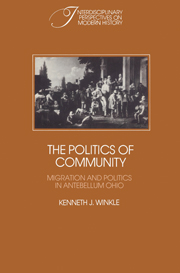Book contents
- Frontmatter
- Contents
- List of tables and figures
- Preface
- Introduction
- 1 The tide of emigration
- 2 An electorate in motion
- 3 From meeting to election: migration and suffrage
- 4 The defended community: migration and elections
- 5 “A movable column”: migration and voting
- 6 The core community: migration and leadership
- 7 Migration and local politics: an antebellum election
- Conclusion
- Notes
- Bibliography
- Index
6 - The core community: migration and leadership
Published online by Cambridge University Press: 06 October 2009
- Frontmatter
- Contents
- List of tables and figures
- Preface
- Introduction
- 1 The tide of emigration
- 2 An electorate in motion
- 3 From meeting to election: migration and suffrage
- 4 The defended community: migration and elections
- 5 “A movable column”: migration and voting
- 6 The core community: migration and leadership
- 7 Migration and local politics: an antebellum election
- Conclusion
- Notes
- Bibliography
- Index
Summary
Students of modern political participation have shown clearly that today a host of demographic factors, including education, occupation, income, age, sex, marital status, race, and mobility, play a prominent role in shaping patterns of political involvement. Similarly, patterns of political participation in antebellum communities reflected a wide variety of demographic as well as political processes. The incessant migration of most voters through the community was the most obvious and important demographic influence on participation. But the socioeconomic status, fertility, aging, mortality, and even geography of nineteenth-century electorates also made prominent impressions on rates of participation. Such demographic trends not only affected patterns of voter turnout but also imposed limits on participation at higher levels, such as officeholding.
The Harrod family of Union Township, Auglaize County, provides a good illustration of the political impact of demography on political participation. The Harrods were one of the most politically powerful families in Union Township. Their power arose, however, not from any unusual political skills or partisan connections nor even through their economic position or social status. An important source of the Harrod family's political power was their demographic stability. The population of Union Township, like that of many other Ohio communities, was unsettled. Union Township's electorate grew by 40 percent between 1850 and 1860, but the township still lost one-half of its adult males during the same decade. The township also accepted 167 immigrants as new voters, an immigration rate of 93 percent.
- Type
- Chapter
- Information
- The Politics of CommunityMigration and Politics in Antebellum Ohio, pp. 109 - 131Publisher: Cambridge University PressPrint publication year: 1988



